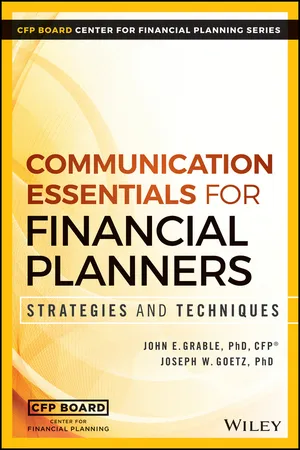
Communication Essentials for Financial Planners
Strategies and Techniques
- English
- ePUB (mobile friendly)
- Available on iOS & Android
Communication Essentials for Financial Planners
Strategies and Techniques
About this book
Exploring the Human Element of Financial Planning
Communication Essentials for Financial Planners tackles the counseling side of practice to help financial planners build more productive client relationships. CFP Board's third book and first in the Financial Planning Series, Communication Essentials will help you learn how to relate to clients on a more fundamental level, and go beyond "hearing" their words to really listen and ultimately respond to what they're saying. Expert coverage of body language, active listening, linguistic signals, and more, all based upon academic theory. There is also an accompanied set of videos that showcase both good and bad communication and counseling within a financial planning context. By merging written and experiential learning supplemented by practice assignments, this book provides an ideal resource for any client-facing financial professional as well as any student on their pathway to CFP® certification.
Counseling is a central part of a financial planner's practice, and attention to interpersonal communication goes a long way toward progressing in the field; this guide provides practical instruction on the proven techniques that make a good financial planner great.
- Build client relationships based on honesty and trust
- Learn to read body language and the words not spoken
- Master the art of active listening to help your clients feel heard
- Tailor your communications to suit the individual client's needs
The modern financial planning practice is more than just mathematics and statistical analysis—at its heart, it is based on trust, communication, and commitment. While interpersonal skills have always been a critical ingredient for success, only recently has this aspect been given the weight it deserves with its incorporation into the certification process. Communication Essentials for Financial Planners provides gold-standard guidance for certification and beyond.
Frequently asked questions
- Essential is ideal for learners and professionals who enjoy exploring a wide range of subjects. Access the Essential Library with 800,000+ trusted titles and best-sellers across business, personal growth, and the humanities. Includes unlimited reading time and Standard Read Aloud voice.
- Complete: Perfect for advanced learners and researchers needing full, unrestricted access. Unlock 1.4M+ books across hundreds of subjects, including academic and specialized titles. The Complete Plan also includes advanced features like Premium Read Aloud and Research Assistant.
Please note we cannot support devices running on iOS 13 and Android 7 or earlier. Learn more about using the app.
Information
CHAPTER 1
An Introduction to Applied Communication
INTRODUCTION
Table of contents
- Cover
- Title page
- Copyright
- Preface
- Acknowledgments
- How to Use This Book
- Introduction
- Chapter 1 An Introduction to Applied Communication
- Chapter 2 Structuring the Process of Interpersonal Communication
- Chapter 3 Structuring the Process of Communication through the Office Environment
- Chapter 4 Listening Skills
- Chapter 5 Questioning
- Chapter 6 Nondirective Communication
- Chapter 7 Directive Communication
- Chapter 8 Trust, Culture, and Communication Taboos
- Chapter 9 Politeness and Sensitivity in Communicating with a Broad Range of Clients
- Chapter 10 Financial Planning—A Sales Perspective
- Solutions
- About the Authors
- About the Companion Website
- Index
- EULA